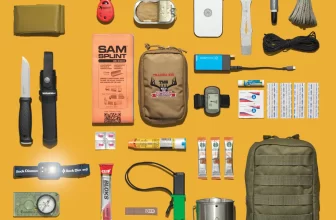Have you ever wondered how much your backpack should weigh when you embark on a multi-day hike? It can be quite a dilemma trying to figure out the perfect balance between packing everything you need and not overloading yourself with unnecessary weight. In this article, we will delve into the factors that determine the ideal backpack weight for a multi-day hike and provide you with some useful tips to help you pack smartly and comfortably.
When it comes to the weight of your backpack, there is no one-size-fits-all answer. The weight you should aim for depends on various factors such as your fitness level, the length of your hike, the terrain you will be traversing, and your personal preferences. A general rule of thumb is to aim for a backpack weight that is no more than 20-25% of your body weight. For example, if you weigh 150 pounds, your backpack should ideally not exceed 30-37.5 pounds.
However, it’s important to note that this is just a guideline, and you can adjust it according to your own comfort and capabilities. If you are an experienced hiker or have a higher fitness level, you might be able to handle a slightly heavier backpack. On the other hand, if you are a beginner or prefer a more lightweight approach, you can aim for a lower backpack weight. The key is to find the right balance that allows you to carry everything you need without straining yourself. In the next section, we will explore some practical tips to help you achieve this. When preparing for a multi-day hike, one of the most important considerations is the weight of your backpack. Carrying excess weight can make your hike more difficult and exhausting, while carrying too little can leave you unprepared for unexpected situations. Finding the right balance is crucial to ensure a successful and enjoyable journey. In this article, we will explore the factors to consider, essential items to pack, strategies to reduce weight, training and conditioning, tips for reducing weight, and the importance of review and adjustment.
Factors to Consider
Duration of the Hike
The duration of your hike plays a significant role in determining the weight of your backpack. If you’re going on a shorter hike, you can afford to carry a heavier backpack since you’ll have fewer supplies and necessities. However, if you’re planning a longer expedition, you’ll need to carefully consider the weight of your gear since you’ll be carrying it for an extended period.
Terrain and Difficulty
The terrain and difficulty of the trail should also be taken into account when determining backpack weight. If you’re hiking on rugged and steep terrain, you’ll need to carry essential gear that will help you navigate the challenges. On the other hand, if you’re hiking on well-maintained trails, you may be able to carry a lighter backpack since the terrain won’t require as much specialized equipment.
Weather Conditions
Weather conditions are a crucial factor to consider when determining backpack weight. If you’re hiking in a cold climate, you’ll need to pack extra layers and insulation to stay warm. Likewise, if you’re hiking in hot and humid weather, you’ll need to carry additional water and ventilation options. It’s essential to research the weather conditions of your intended hike and pack accordingly to ensure your safety and comfort.
Essential Items
Tent and Sleeping Bag
When it comes to multi-day hikes, a quality tent and sleeping bag are essential items. Your tent will provide shelter from the elements, while your sleeping bag will keep you warm and comfortable at night. Both of these items should be lightweight and durable to minimize the weight of your backpack.
Cooking Equipment
If you plan to prepare your meals during the hike, you’ll need to carry cooking equipment such as a stove, pot, utensils, and a water purifier. While it’s important to have the necessary tools for cooking, it’s equally important to select lightweight options to reduce your backpack weight.
Clothing and Layers
Choosing the right clothing and layers is crucial for multi-day hikes. You’ll need to pack clothes suitable for the expected weather conditions, including base layers, insulation layers, and outer shells. It’s important to strike a balance between warmth and weight when selecting your clothing and layers.
Weight Distribution
Proper Packing Techniques
Once you’ve determined the essential items to carry, it’s crucial to pack them properly to distribute the weight evenly in your backpack. Place heavier items closer to your back and higher in the pack to maintain balance and stability while hiking.
Balancing the Load
When loading your backpack, it’s essential to balance the weight on both sides to avoid straining one side of your body. Make sure the load is evenly distributed to prevent discomfort and potential injuries.
Weight on Shoulder and Hips
The proper distribution of weight between your shoulders and hips is crucial for comfort and stability during a multi-day hike. The majority of the weight should be supported by your hip belt, allowing your shoulders to carry a smaller percentage of the load. This helps to reduce strain and fatigue on your upper body.
Recommended Weight Range
Guidelines by Experts
While it’s difficult to define an exact weight limit for a multi-day hike, experts generally recommend keeping your backpack weight between 20% and 30% of your body weight. This range ensures that you have the necessary gear and supplies without risking physical discomfort or fatigue.
Percentage of Body Weight
Calculating the weight of your backpack as a percentage of your body weight helps provide a general guideline for backpack weight. For example, if you weigh 150 pounds, your backpack should ideally weigh between 30 and 45 pounds. This range allows for variation in individual fitness levels and hiking experience.
Comfort vs. Safety
While it’s important to prioritize comfort, safety should always be the primary concern. If carrying a heavier backpack is necessary to ensure your safety during a multi-day hike, it’s worth sacrificing some comfort in exchange for preparedness. Remember, the weight of your backpack should never compromise your ability to safely navigate the trail.
Strategies to Reduce Weight
Choose Lightweight Gear
Investing in lightweight gear is one of the most effective ways to reduce your backpack weight. From tents and sleeping bags to cooking equipment and clothing, there are numerous options available that are specifically designed to be lightweight without compromising functionality.
Minimize Redundant Items
Take a critical look at the items you’re planning to pack and eliminate redundancies. Avoid duplicates or items that serve the same purpose. Additionally, consider the possibility of borrowing or sharing gear with other hikers to further reduce weight.
Share Common Gear with Group
If you are hiking with a group, consider sharing common gear, such as a tent or cooking equipment. This not only reduces the overall weight that needs to be carried by each individual but also fosters a sense of community and cooperation.
Training and Conditioning
Building Strength and Endurance
Preparing your body for the physical demands of a multi-day hike is essential. Regular exercise, such as strength training and cardio workouts, will help build the necessary strength and endurance needed for carrying a backpack over long distances.
Practice Hiking with Weight
Before embarking on a multi-day hike, it’s advisable to practice hiking with a loaded backpack. Start with shorter hikes and gradually increase the duration and weight. This will help your body adapt to the added load and minimize the risk of injury.
Gradual Progression
When increasing the weight of your backpack or the duration of your hikes, it’s important to do so gradually. Pushing yourself too hard too soon can lead to injuries and setbacks. Gradual progression allows your body to adapt over time, improving your overall hiking performance.
Importance of Prioritizing
Identifying Necessities
Identifying and prioritizing the necessities is crucial when determining your backpack weight for a multi-day hike. Consider the essentials required for survival, such as shelter, food, and water, as well as any additional items that are specific to your comfort or safety needs.
Weighing Necessity vs. Comfort
While it’s natural to desire comfort during a multi-day hike, it’s important to strike a balance between necessity and comfort. Assess each item in your backpack and determine if it is truly necessary for the journey. This will help you eliminate any non-essential items and reduce unnecessary weight.
Trade-offs and Sacrifices
Reducing backpack weight often involves making trade-offs and sacrifices. It may mean leaving behind certain luxuries or reducing the quantity of certain items. It’s important to remember that the more you can reduce your backpack weight, the more enjoyable and manageable your hike will be.
Tips for Reducing Weight
Limit Food and Water Weight
Food and water are some of the heaviest items you’ll carry on a multi-day hike. Opt for lightweight, high-calorie food options and consider the availability of water sources along the trail to reduce the amount you need to carry.
Repackage and Downsize
Repackaging items into smaller containers and downsizing packaging can significantly reduce weight. Transfer food into resealable plastic bags, condense toiletries into travel-sized containers, and remove unnecessary packaging from items whenever possible.
Choose Efficient Gear
When selecting gear, choose options that serve multiple purposes or have dual functionality. This will help reduce the number of items you need to carry while still meeting essential needs. For example, a lightweight hiking pole that doubles as a tent pole can save weight and space in your backpack.
Review and Adjust
Periodic Evaluation of Pack Weight
Periodically evaluating the weight of your backpack is essential to ensure you’re not carrying unnecessary items. As you gain experience and learn more about your needs and preferences, you can make adjustments to further optimize your pack weight.
Learn from Experience
Each multi-day hike offers valuable lessons and insights. Pay attention to the items you didn’t use or items that proved to be unnecessary. Use this knowledge to refine your packing list for future hikes and continue to lighten your load.
Optimize for Future Hikes
While each hike is unique, there are certain commonalities that can be applied to future hikes. Continuously optimize your pack weight by incorporating what you’ve learned from past experiences and applying it to future hikes. This will help make each journey more enjoyable and less physically taxing.
Conclusion
Finding the right balance for your backpack weight on a multi-day hike is a personalized approach. Consider the factors such as duration, terrain, and weather conditions to determine the essential items you need to pack. Focus on weight distribution, recommended weight ranges, and strategies to reduce weight. Prioritize safety while striving for comfort and enjoyment. Train your body and gradually increase your endurance. Identify necessities and make trade-offs to achieve the ideal backpack weight. Remember to periodically review and adjust your pack weight based on past experiences. With careful planning and conscious decision-making, you can optimize your backpack weight and ensure an enjoyable multi-day hike. So, pack your bag, put on your hiking boots, and embark on the adventure of a lifetime!








